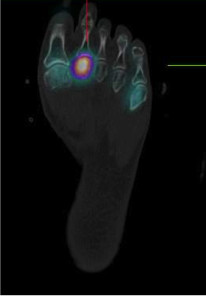Jason R. Miller, Karl W, Dunn, Louis J. Ciliberti Jr., Rikhil D. Patel, Brock A. Swanson.
Published in The Journal of Foot & Ankle Surgery 2016, Feb (55): 117-120.
Vitamin D is an essential, fat-soluble nutrient that is a key modulator of bone health. Despite the gaining popularity throughout published medical studies, no consensus has been reached regarding a serum vitamin D level that will guarantee adequate skeletal health in a patient with an increased functional demand. The purpose of the present investigation was to examine the serum concentrations of vitamin D in patients with confirmed stress fractures. A total of 124 patients were included in our retrospective cohort study. Of the 124 patients, 53 had vitamin D levels measured within 3 months of diagnosis. An association was seen in patients with a stress fracture and vitamin D level measured, as 44 (83.02%) of the 53 patients had a serum 25-hydroxyvitamin D level <40 ng/mL. Although an association was seen at our institution in patients with stress fractures and a serum vitamin D concentration <40 ng/mL, a larger and prospective investigation is warranted to further understand the effect of vitamin D level and stress fracture prevention in an active, nonmilitary population.
Comments:
Though this is a retrospective study it indicates Vitamin D levels should be checked in those with stress fractures and has important implications for managing stress fractures at any age. Metatarsal stress fractures were the commonest in the population studied.
The paper notes
“We would advocate high-dosage supplementation for individuals with a 25(OH)D of < 35 ng/mL, introducing a 4- to 8-week regimen of a 50,000-IU weekly dose until fracture healing has occurred,” and “For those with a serum concentration of 35 to 40 ng/mL, we would recommend 3000 to 5000 IU daily.”

